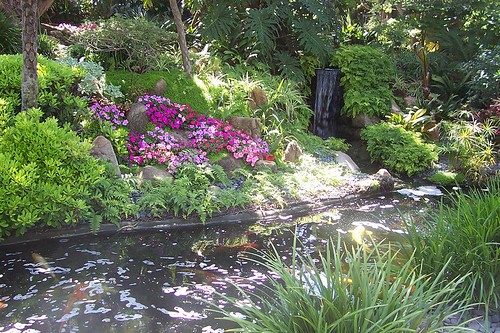
This is the third post in a three part series on creating a meditation garden. You can see the first post about creating a meditation garden here, where I discussed some questions you need to answer first before you start building a meditation garden. In the second post on meditation gardens, I talked about creating a green meditation garden by using hosta lily plants.  In this post, I will discuss some other meditation garden ideas.
To add to the green meditation garden, consider interspersing the garden with ferns. There are numerous ferns for sites like you describe. Fern leaves flow so nicely in the breeze and some stay green in the winter when the hostas die back. Taller varieties would look lovely. A fern and hosta website is here.
If a monochromatic garden with just green does not appeal, consider planting a Japanese maple. But be sure to get the ones that do not grow too tall. Japanese maples give 3 seasons of color. Some turn a different shade in the fall.  See here.
Another tree that would look lovely if you have the space is the dogwood. But I would not consider the native dogwood, as much as TheGardenLady loves it, because it might not be hardy enough. I suggest the Korean dogwood, Cornus kousa. See here. I have only seen a white flower on it. But it has one of the most interesting fruits which makes it of interest for two seasons.
Shade loving shrubs are azaleas and s. There are now azaleas that bloom all summer long. See here. With the greens of the hostas, I would love to see white flowers.
Would you consider underplanting with bulbs? The hostas can be planted next to or over spring bulbs. If daffodils are the bulbs chosen, they will bloom first and their leaves will cover the barren places where the hostas are. The time the hostas emerge is when the daffodils die. Since you must never cut the daffodil leaves, which look ugly when the flowers die, the hosta leaves will hide the daffodil leaves.
If you want real punches of color, you can plant annuals seasonally in between the hostas. Consider begonias. Wax begonias are excellent because they like shade. My favorite begonias are the tuberous begonias. Though most recommend that tuberous begonias be planted in pots, I have seen them growing in a churchyard cemetery in Switzerland. I decided then, if I couldn’t be Heidi as a young girl living in the Swiss mountains, I wanted to be buried in that churchyard. Because the tubers have to be dug up in the fall, if you want to make your life easy for yourself and no one will steal anything, you can grow any flowering annuals in pots and then place them strategically in the meditation garden when the hostas are up. Some other shade tolerant flowers: Lobelia grows well in the shade. And don’t forget impatiens. Both common and New Guinea impatiens like shade though New Guinea impatiens are more tolerant of sun as long as they are kept moist. Also consider coleus. Though not grown for the flowers, the leaves are as colorful as flowers. And the new varieties are spectacular. At the end of the season, you can snip off the leaves and start new plants for next year.
With the path and seating, I hope you put in a water feature. There is something relaxing about a fountain. Or if you get a birdbath, the water will attract birds. If you decide you want to try a small water garden, if you put it in the sunniest part of the garden, you can buy some water flowers which like at least 4 hours of sun.
Call your local Master Gardener office and ask them for advice on plants in your area. Also, ask them if they can donate their time and/or plants for your garden. Often Master Gardeners will take on a project if it is for a public space or they will put out a call among themselves for plants they can donate.
Good luck in your endeavor. Please send photos of your meditation garden – at all stages of its growth- and write something about your successes and failures in creating this garden for TheGardenLady and her readers.

superb article here at http://www.thegardenlady.org/2009/06/12/creating-a-meditation-garden-part-iii-adding-color/ . Thiking to translating your copy into spanish for our visitors. Will let you know after I talk to our writers. many thanks.